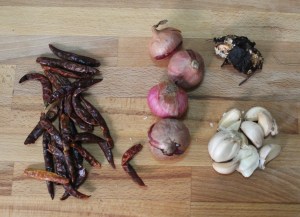This one is going to be the last in the series, for now. We added coconut, then included roasted/fried lentils to gooseberries. Why leave the beautiful tomatoes, that are used in several chutneys/dips to give texture, colour and flavor? So, this time it is the turn of tomatoes to do the honours for gooseberries.
I have added coconut too, as I find it difficult to imagine a thuvayal without coconut. Certainly, coconut provides added flavour to tomato chutney, even without gooseberry. If one would like to omit the coconut in this chutney, please go ahead. It tastes as good as it would with coconut.
Nellikkai Thakkali Thuvayal/Gooseberry Tomato Chutney




Ingredients (serves 4)
- periya nellikkai/gooseberry (bigger variety) – 5 no.s chopped
- thengai/coconut – 1/4 of one- finely chopped/grated
- milagai vatral/redchillies- 10 or as preferred
- chinna vengayam/shallots- 8 no.s
- poondu/garlic– 8-10 cloves
- thakkalli/tomato- 4 no.s
- uppu/salt – to taste
- yennai/oil – 1 tsp
Method of Preparation
- Peel shallots, grate coconut, chop tomatoes and gooseberries
- In a pan, take a tsp of oil. Fry red chillies, garlic and shallots, and fry till shallots become opaque
- Add the chopped tomatoes and fry till soft and slightly mushy
- Switch off the stove. Let the fried stuff cool a bit
- In the blender jar, add grated coconut and chopped gooseberries
- Add the fried ingredients
- Add salt and water and blend to a smooth paste
- First blend with very little water, as tomatoes would have some moisture to make the thuvayal
- Add more if needed
- This thuvayal tastes best with seasoning.
thaalippu – seasoning
- yennai/oil – 2 tsp
- kadugu/mustard seeds – 1/2 tsp
- ulundham paruppu/skinned black gram – 1 tsp
- kariveppilai/curry leaves- 5/6
- Heat oil in a small pan
- Add mustard seeds
- When they splutter add black gram
- When it becomes golden brown, add curry leaves
- Pour this into the thuvayal.
I think I didn’t have curry leaves, while making and clicking this chutney. That’s why picture doesn’t have them.
Serve with Idli, Dosai, Uthappam or any main course of your choice.























